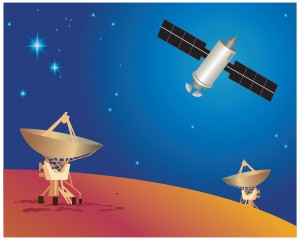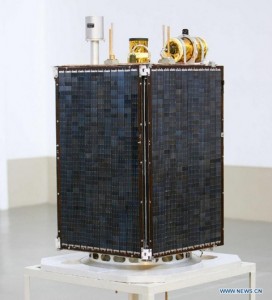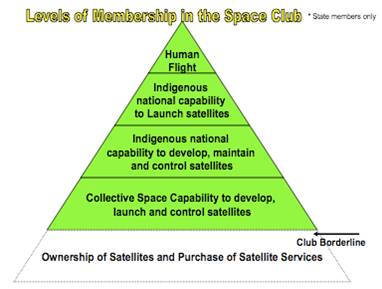A Space Launch without a Space Program
 The DPRK has sparked another diplomatic confrontation with its announcement that it intends to place a satellite in orbit as part of a peaceful space program. Often overlooked is the fact that while the DPRK has missiles, it does not yet have a recognizable space program.
The DPRK has sparked another diplomatic confrontation with its announcement that it intends to place a satellite in orbit as part of a peaceful space program. Often overlooked is the fact that while the DPRK has missiles, it does not yet have a recognizable space program.
Missiles are in the news again with North Korea’s announcement that it would attempt a space launch between April 12th and 16th to mark the 100th birthday of the “Eternal President” Kim Il Sung. As with the space launch attempt in 2009, the DPRK transmitted notices to the International Maritime Organization (IMO), the International Civil Aviation Organization (ICAO), and the International Telecommunications Union (ITU). The IMO and ICAO notices warned of falling rocket bodies, with the first stage projected to come down off the western coast of South Korea and the second stage impacting just north of the Philippines. Unlike its two prior launch attempts, the trajectory would be due south from a launch site near the village of Tongchang-ri in the northwest part of the country.
The United States, Russia, Japan, South Korea, and China have reacted predictably, criticizing any launch attempt as a violation of multiple United Nations Security Council Resolutions, notably UNSCR 1718 (2006) and 1874 (2009), barring ballistic missile activities. China has been the most circumspect, while the Japanese Defense Minister has said that his country was preparing ballistic missile defenses against a possible threat to its territory. Assuming the launch attempt will be on a southern trajectory as announced, there should be no immediate risk, but tensions have nonetheless been rising, as the DPRK has sent rockets over Japan in the past.
In response to international reaction, the Korean Central News Agency (KCNA) stated: “Our satellite launch has nothing to do with” the nuclear deal with Washington because a satellite launching and a long-range missile are “two separate things.” This is, of course, false on technical grounds, as the engineering skills required for both are the same. It is also false on legal grounds, as the current international sanctions demonstrate.
Is it possible that North Korea has a peaceful space program and therefore the intent of a launch attempt is separable from a long-range ballistic missile program? Again, the answer appears to be “no” for now. Media reports about the Tongchang-ri (Sohae) launch site have speculated that it is or will soon be capable of handling larger vehicles, perhaps comparable to the early Chinese Long March rockets, that would more clearly be designed for space launch purposes. Thus, it is possible that the DPRK may eventually develop a genuine peaceful space program in addition to its ballistic missiles, just as other countries have done in the past. US rocket programs in the 1950s were designed to develop better delivery systems for nuclear weapons and replace high-altitude reconnaissance aircraft by satellites in gathering information over the Soviet Union and other areas. Soviet rocket programs were all about the delivery of nuclear weapons, then prestige demonstrations, and only later for science. There was a similar pattern for China with an emphasis on nuclear weapons.
But, for now, if we look beyond the DPRK’s development of launchers, there is little to no evidence for concluding that the North is serious about its peaceful space activities. The DPRK claim to be a space-faring state is largely based on its two prior launch attempts and its failed efforts to place a satellite in orbit. The first was the 1998 launch of Kwangmyongsong-1, a communications satellite similar to China’s first satellite, the 1970 Dong Fang Hong 1. The Kwangmyongsong-1 was supposed to have operated on 27 MHz, a frequency commonly used for radio-controlled model planes and other toys. The second, the 2009 launch of Kwangmyongsong-2, was also intended to be a communications satellite using a 470 MHz frequency, consistent with space-to-Earth telemetry bands. In 2009, the IMO and ICAO communicated the DPRK launch warning to its members, but the ITU dismissed DPRK claims of a successful satellite launch, saying that it had no information about a satellite or reports of communications with it. There is no evidence that either satellite made it to orbit and no signals were ever heard from them.
 For the upcoming April launch, the DPRK claims that its Kwangmyongsong-3 satellite will take images of the Earth from space to estimate crop production and monitor natural resources. The announced polar orbit of 310 miles is almost a “sun-synchronous orbit” typically used by Earth observation satellites. The Kwangmyongsong-3 is supposed to transmit remote sensing data on a UHF band and video on X-band. (Satellites, as well as amateur radio operators, use the UHF band.) The higher frequency X-band is used for government satellite communications. Recent media images of the satellite show what appear to be the UHF and X-band antennas, along with what may be a tracking/scanning mirror or horizon sensor and a fixed low-resolution digital camera. From the size of the solar panels, which may be hinged for deployment, satellite power could be about 200 watts. The announced mass of 100 kilograms is very small for an observation satellite but still feasible largely with internationally available parts and components.
For the upcoming April launch, the DPRK claims that its Kwangmyongsong-3 satellite will take images of the Earth from space to estimate crop production and monitor natural resources. The announced polar orbit of 310 miles is almost a “sun-synchronous orbit” typically used by Earth observation satellites. The Kwangmyongsong-3 is supposed to transmit remote sensing data on a UHF band and video on X-band. (Satellites, as well as amateur radio operators, use the UHF band.) The higher frequency X-band is used for government satellite communications. Recent media images of the satellite show what appear to be the UHF and X-band antennas, along with what may be a tracking/scanning mirror or horizon sensor and a fixed low-resolution digital camera. From the size of the solar panels, which may be hinged for deployment, satellite power could be about 200 watts. The announced mass of 100 kilograms is very small for an observation satellite but still feasible largely with internationally available parts and components.
Given what we know about the current state of DPRK technical capacities, while admittedly imperfect and subject to error, it is surprising that North Korea would attempt to build and operate such a microsatellite when it has yet to successfully demonstrate much simpler capabilities. It is conceivable that the necessary technologies and expertise were acquired from overseas but long-standing sanctions would have made that course difficult and expensive. China supported the North’s development of the Kwangmyongsong-1 satellite, but appears to have reduced or ceased its support of satellite efforts after the first two launch attempts.
Certainly, the North has taken steps to make an international case that it should be treated as if it had a space program. In the month before its 2009 launch attempt, North Korea became party to the 1967 Outer Space Treaty and the 1974 Convention on Registration of Objects Launched into Outer Space, two fundamental international agreements of space law. The DPRK notifications to ICAO and the IMO in 2009, and more recently in 2012, characterize the launches as legitimate, peaceful space activities. Yet, despite public claims of two successful satellite launches, the DPRK has not registered them with the United Nations as required, although even if it had, that would not change the reality of UN sanctions. Finally, on November 29, 2011, Pyongyang issued a brief space “white paper” (via KCNA) entitled, “Space is Common Wealth of Humankind,” in which the DPRK listed civil and commercial space applications and said that US opposition to the “DPRK’s peaceful satellite launch” was part of a US strategy to monopolize space and for “world domination.”
It is common to speak of nation states as belonging to the “space club” based on their ability to exploit and use space, ranging from human exploration at the highest levels to practical applications such as communications, navigation, agriculture, construction, etc. This club can be thought of as having several levels based on demonstrated technical capabilities as illustrated in Figure 1. The foundation of the pyramid is the ability to exploit space technology for practical applications of all kinds. In this area, the DPRK is behind other developing countries due to restrictions on the kinds of information products that are a primary strength of space-based systems. As a comparison, Vietnam might be seen as just barely in the club due to its acquisition and use of a communications satellite, while South Korea is developing a domestic capability to launch satellites after having mastered earlier levels.
Figure 1: Space Club Levels[1]

Based on this commonly understood framework for space club membership, the DPRK falls short when evaluated on a number of criteria. For example, the North has a mixed record when it comes to attending international meetings or belonging to global space organizations. Every three to four years, the ITU holds a conference to update international spectrum allocations, including those used by all space services. At the 2012 meeting in Geneva attended by over 100 countries, there were 60 representatives from South Korea, 148 from the United States, and four from the DPRK, all from the permanent mission in Geneva with other responsibilities. The North does participate in meetings of the Asia Pacific Telecommunity that prepare regional positions on spectrum allocations for ITU meetings and meetings of the World Meteorological Organization on topics such as flood control and disaster management. However, there are no representatives in dedicated space organizations, such as the UN Committee on the Peaceful Uses of Outer Space (COPUOS). This lack of engagement also includes organizations open to individual scientists, such as the International Academy of Astronautics.
Perhaps even more important, the DPRK lacks the technical and organizational characteristics of states with a serious commitment to space research, development, and operations. Pyongyang has not yet demonstrated the ability to construct or even operate communications satellites, interpret data from remote sensing systems, or even engage in cooperative international space science research. In comparison to other countries in the Asia-Pacific region, the sophistication of the DPRK’s space efforts might be placed behind Bangladesh and Mongolia, and perhaps comparable to Myanmar and Bhutan. Bangladesh and Mongolia have dedicated centers for space applications like remote sensing as well modest space science projects. Bangladesh has dedicated meteorological ground stations, image processing, geographic information systems, and related mapping facilities. The National Remote Sensing Center of Mongolia supports local capabilities for monitoring natural resources and the environment, as well as assessing natural disasters and pollution effects.
In contrast, Myanmar and Bhutan are poorer countries that have only the most basic meteorological and mapping capabilities that could use space-based data. Since Bhutan is open to outside assistance in a way that Myanmar is not, Myanmar might be considered the closest civil space analog to North Korea. Such a comparison obviously leaves aside the DPRK’s missile program, which represents a significant technical capability and cadre of skilled personnel. However building rocket engines is not the same as building advanced electronics and mastering information technologies necessary for successful civil space applications—as the Soviet space program has demonstrated. The North may have a nascent launch vehicle, but it does not appear to have the capability to benefit from space applications as much as Bhutan.
In short, if Pyongyang’s upcoming launch is successful in putting a remote sensing satellite in space and it works, inevitable questions follow: where is the data going, who is processing it and how will the information be used? Aside from launch vehicles, virtually all space applications, including remote sensing satellites, are information-intensive technologies that function most effectively only when they are part of larger information networks. A satellite in orbit is largely meaningless without an ability to return useful data to the ground where it can be combined with other sources of information in international scientific and commercial communities. The North’s isolation and lack of transparency highlights the differences between having a space capability and having a peaceful space program.
There is no shortage of useful civil and scientific space applications that North Korea might pursue if it chose to do so. Virtually all of them would initially involve information-intensive applications such as those for weather prediction, remote sensing for agriculture, water and natural resource management, expansion of maritime and aviation mobile satellite communications, and satellite-based positioning and navigation, perhaps using the emerging Chinese COMPASS satellite system. Peaceful space development could proceed in a manner similar to other countries in the region—with a mixture of scientific projects and space applications that would directly benefit the North Korean population. Improved domestic and international communications, better disaster management, more transparent management of natural resources, and more productive infrastructures are all possible benefits from space.
Because of the North’s past track record, its ongoing nuclear weapons program and the absence of a clear commitment to developing a civil space program, it is hard to believe Pyongyang’s assertion that this launch is “peaceful.” More obvious motivations for the upcoming launch include further developing the technology necessary to deliver nuclear weapons, achieving a propaganda win over South Korea—which has had its own recognized space launch failures—and continuing a sense of crisis that strengthens domestic political support. (A successful launch would also increase arguments within South Korea that it needs to extend the range of its own ballistic missiles, thus increasing the risk of crisis instability and regional conflict.)
When thinking of the words “North Korea” and “space,” perhaps the first image that comes to mind is that of the stark darkness that weather satellites have documented for the terrain north of the DMZ. In contrast to the lights of Seoul, Tokyo, or Beijing, North Korea is as dark at night as the wilderness of the Kamchatka Peninsula. A genuine DPRK space program would be one that would help create lights on the ground through economic development and practical civil space applications, before building rockets. A genuine DPRK space program that is more than a cover for ballistic missile developments, and open to international engagement would represent a very different North Korea than the one we are faced with today.
[1] Deganit Paikowsky, “The Space Club—Space Policies And Politics,” IAC-09.E3.3.5, paper presented at the 60th meeting of the International Astronautical Congress, Daejeon, Korea, October 2009.
